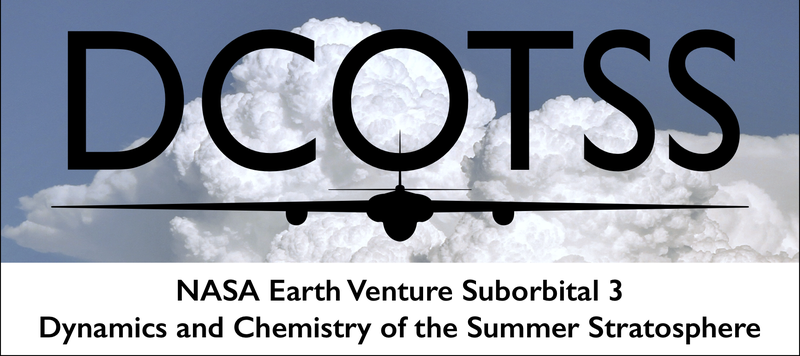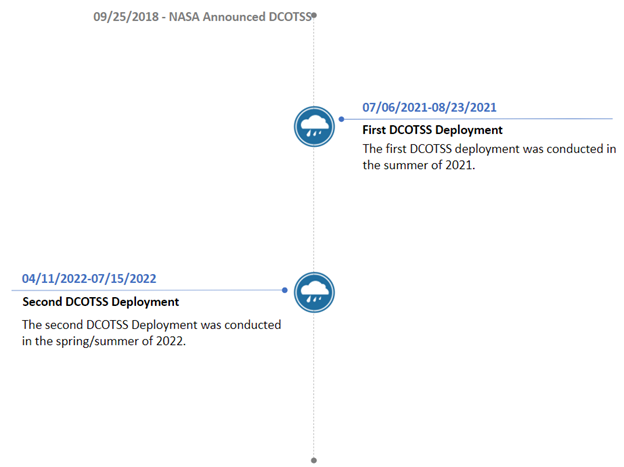Understanding the North American Monsoon Anticyclone with DCOTSS
Understanding the North American Monsoon Anticyclone with DCOTSS
Each summer, the North American Monsoon Anticyclone (NAMA) dominates the circulation of the North-Western Hemisphere and acts to partially confine and isolate air from the surrounding atmosphere. Because of NAMA, strong convective storms develop over North America and overshoot the tropopause into the lower stratosphere. These storms carry water and pollutants from the troposphere into the stratosphere, which is typically very dry. This process can have a very significant impact on radiative and chemical processes, potentially including stratospheric ozone. Studying this process is the main objective of the Dynamics and Chemistry of the Summer Stratosphere (DCOTSS) campaign. DCOTSS is one of five Earth Venture Suborbital campaigns that began in 2019. Over the six-year campaign, the NASA ER-2 High Altitude Research Aircraft deployed for two 7-week science deployments out of Salina, KS to cover the period from early to late summer. The ER-2 aircraft was equipped with a payload providing in-situ measurements for trace gases, aerosols, reactive species, and meteorological parameters in the study area. The DCOTSS instrument payload brought together twelve proven instruments for in-situ measurements necessary to complete the objectives of the campaign (instruments listed below). The Next Generation Weather Radar (NEXRAD) network paired with operational modeling, and NASA and NOAA earth observing satellites were used to collect in-situ and remote sensing measurements to study the interaction between the storms and the stratosphere. This campaign will advance the understanding of changes in the Earth’s radiative balance, air quality, and the ozone layer that result from changes in atmospheric composition. DCOTSS will also improve the ability to predict weather and extreme weather events. Results from DCOTSS will be used to determine what dynamical mechanisms lead to irreversible stratospheric injections of air in the NAMA due to convection, and how the air is exported to the global stratosphere.
All currently available publication quality data is archived and distributed at the Atmospheric Science Data Center (ASDC) at NASA Langley Research Center. Additional information and data access can be found at the ASDC DCOTSS project landing page. Additional publication-quality data will become available soon.

Image Source:
NASA/DCOTSS
Spatial Coverage:
[N: 47, W: -123, S: 25, E: -80] degrees
Temporal Coverage:
2021-2022
Scientific Objectives
Research Questions:
- How much tropospheric air and water is irreversibly injected into the stratosphere by convection?
- What convective source regions impact the NAMA?
- What chemical changes take place in the stratosphere due to convection in the NAMA?
- What is the background chemical and thermodynamic state of the Lower Stratosphere (LS) over North America during summer?
Objectives:
- Advance the understanding of changes in the Earth’s radiation balance, air quality, and the ozone layer that results from changes in atmospheric composition.
- Improve the capability to predict weather and extreme weather events.
Instruments Used
The platform used by DCOTSS is the NASA ER-2 high altitude research aircraft equipped with various instruments listed below.
| Platform Type | Platform | Relevant Instrument | Study Area |
|---|---|---|---|

|
1. Compact Airborne Formaldehyde Experiments (CAFÉ) Compact Airborne Nitrogen diOxide Experiments (CANOE) Harvard Halogens (HAL) Harvard Water Vapor (HWV) 2. Harvard University Pacarro Cavity Ringdown Spectrometer (HUPCRS) Particle Analysis by Laser Mass Spectrometry - Next Generation (PALMS-NG) DCOTSS Printed Optical Particle Sampler (DROPS) UAS Chromatograph for Atmospheric Trace Species (UCATS) 3. Advanced Whole Air Sampler (AWAS) 4. Water Isotopologues (Integrated Cavity Output Spectrometer (WI-ICOS) 5. Rapid OZone Experiment (ROZE) Meteorological Measurement Systems (MMS) |
1. Fluorescence 2. Spectrometry (in situ) 3. Whole Air Sampling 4. Laser Absorption 5. Other |
Access Data
The ASDC archives and distributes all currently available publication-quality data from DCOTSS. In the future, the ASDC will distribute additional publication-quality data from the first two deployments. Data from DCOTSS can be accessed on the ASDC DCOTSS landing page, as well as Earthdata Search (insert DCOTSS EDS link once it's created).
Events of Interest
This section highlights events within the field campaign of particular scientific interest.

The first deployment of DCOTSS was conducted in the summer of 2021, one year after originally scheduled with delays caused by the COVID-19 pandemic. The goal of the first DCOTSS deployment was to provide much needed observational data for researchers on the impact of summer thunderstorms on stratospheric ozone, water vapor, and aerosols. The aim of these findings is to improve our current scientific understanding of the Earth system and enhance our ability to predict climate, weather, and natural hazards – which are critical components of the NASA Earth Science Enterprise Strategic Plan.
The second DCOTSS deployment was a 13-week deployment beginning Late-Spring/Early-Summer 2022. The deployment occurred between April 11 and July 15, 2022. Science flights for this deployment lasted around 4 and a half weeks from May 29 – June 29, 2022.
Relevant Publications
Feng, Z., R.A. Houze, L.R. Leung, F. Song, J.C. Hardin, J. Wang, W.I. Gustafson, and C.R. Homeyer, 2019. Spatiotemporal characteristics and large-scale environments of mesoscale convective systems east of the Rocky Mountains, J. Climate, 32, 7303–7328, doi: 10.1175/JCLI-D-19-0137.1.
Siu, L. W.*, and K. P. Bowman, 2019. Forcing of the upper-tropospheric monsoon anticyclones, J. Atmos. Sci., 76, 1937–1954, doi: 10.1175/JAS-D-18-0340.1.
Bedka, K., E.M. Murillo, C.R. Homeyer, B. Scarino, and H. Mersiovsky, 2018. The above-anvil cirrus plume: An important severe weather indicator in visible and infrared satellite imagery, Weather and Forecasting, 33, 1159–1181, doi: 10.1175/WAF-D-18-0040.1.
Liu, N., and C. Liu, 2018: Synoptic environments and characteristics of convection reaching the tropopause over Northeast China, Mon. Wea. Rev., 146, 745–759, doi: 10.1175/MWR-D-17-0245.1.
Cooney, J. W., K. P. Bowman, C. R. Homeyer, and T. M. Fenske, 2018. Ten-year analysis of tropopause-overshooting convection using GridRad data, J. Geophys. Res., 123, 329–343, doi: 10.1002/2017JD0277181.
Homeyer, C. R., and K. P. Bowman, 2017. Algorithm Description Document for Version 3.1 of the Three-Dimensional Gridded NEXRAD WSR-88D Radar (GridRad) Dataset, Technical Report.
Smith, J. B., D. M. Wilmouth, K. M. Bedka, K. P. Bowman, C. R. Homeyer, J. A. Dykema, M. R. Sargent, C. E. Clapp, S. S. Leroy, D. S. Sayres, J. M. Dean-Day, T. P. Bui and J. G. Anderson, 2017. A case study of convectively sourced water vapor observed in the overworld stratosphere over the United States, J. Geophys. Res., 122, 9529–9554, doi: 10.1002/2017JD026831.
Anderson, J. G., D. K. Weisenstein, K. P. Bowman, C. R. Homeyer, J. B. Smith, D. M. Wilmouth, D. S. Sayres, J. E. Klobas, S. S. Leroy, J. A. Dykema, and S. C. Wofsy, 2017. Stratospheric ozone over the United States in summer linked to observations of convection and temperature via chlorine and bromine catalysis, Proc. Nat. Acad. Sci., 114, E4905–E4913, doi: 10.1073/pnas.1619318114.
Homeyer, C. R., J. D. McAuliffe, and K. M. Bedka, 2017: On the development of above-anvil cirrus plumes in extratropical convection, J. Atmos. Sci., 74, 1617–1633, doi: 10.1175/JAS-D-16-0269.1.
Bedka, K.M. and K. Khlopenkov, 2016. A probabilistic multispectral pattern recognition method for detection of overshooting cloud tops using passive satellite imager observations, J. Appl. Meteor. and Climatol., 55, 1985–2005, doi: 10.1175/JAMC-D-15-0249.1.
Liu, N., and C. Liu, 2016. Global distribution of deep convection reaching tropopause in one-year GPM observations, J. Geophys. Res., 121, doi: 10.1002/2015JD024430.
Solomon, D. L., K. P. Bowman, and C. R. Homeyer, 2016. Tropopause-penetrating convection from three-dimensional gridded NEXRAD data, J. Appl. Meteor. and Climatol., 55, 465–478, doi: 10.1175/JAMC-D-15-0190.1.
Homeyer, C. R., K. P. Bowman, L. L. Pan, M. A. Zondlo, and J. F. Bresch, 2011: Convective injection into stratospheric intrusions, J. Geophys. Res., 116, D23304, doi: 10.1029/2011JD016724.
Reference Sources
YouTube: NASA's ER-2 High Altitude aircraft prepared for DCOTSS mission